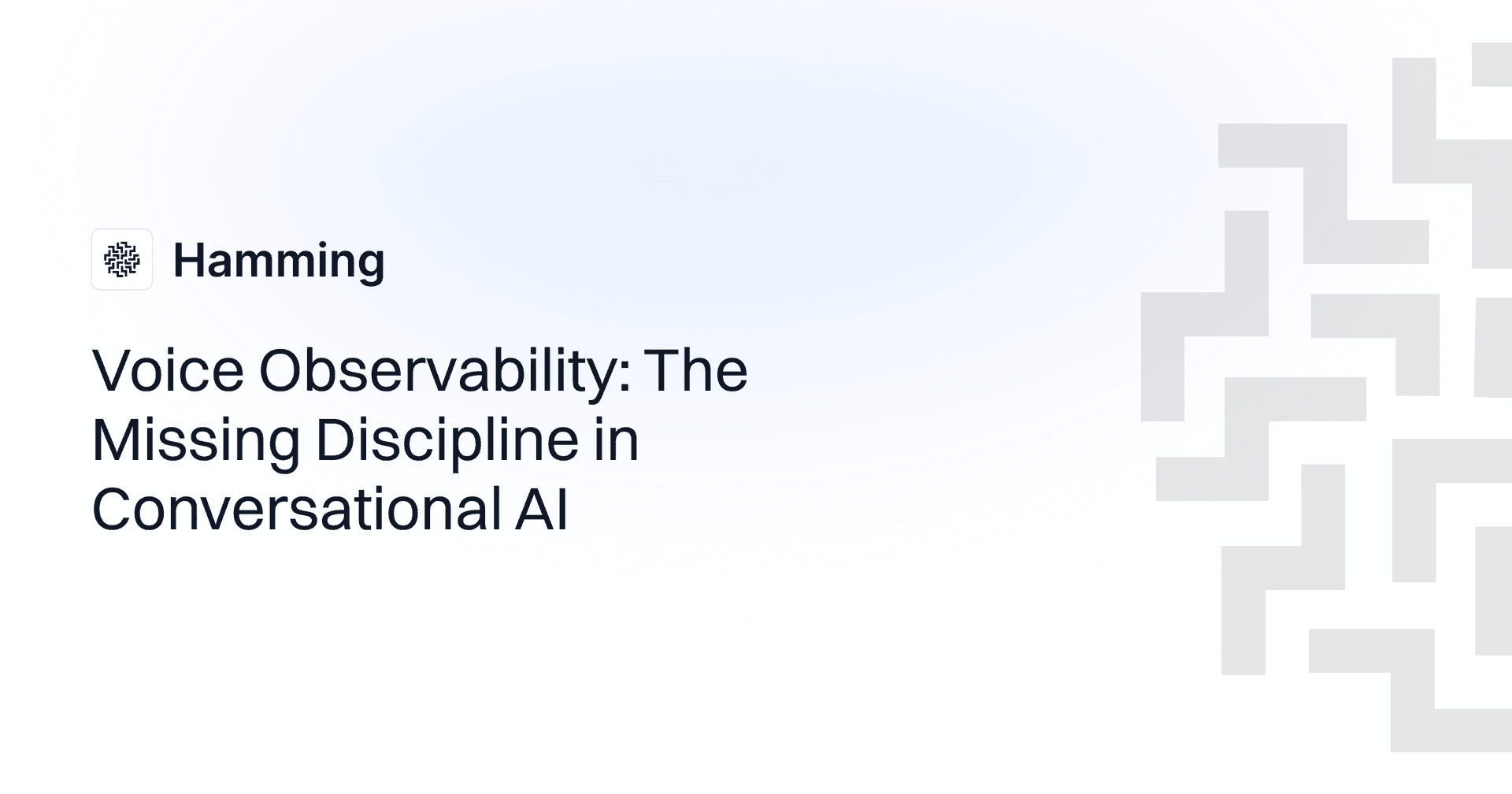Voice Observability: The Missing Discipline in Conversational AI
I asked a customer last quarter how they debugged a voice agent issue that had affected 2,000 calls. "We pulled the logs from three systems, correlated timestamps in a spreadsheet, and listened to about 40 recordings," they said. It took their team two days to find the root cause: a single prompt change had shifted how the agent handled a common intent.
The same team could trace a failed database query in under a minute. They had distributed tracing, structured logs, and real-time dashboards for their backend services. But for their voice agent—the system actually talking to customers—they were back to spreadsheets.
Modern engineering teams maintain comprehensive observability across their entire stack. Every API call generates logs, every database query produces traces, every server metric streams to dashboards with millisecond precision. Teams can replay exact conditions from production incidents and precisely trace individual requests.
Voice agent teams don't have this. They may be able to trace failed database queries through complete execution plans but struggle to explain interruption patterns in customer conversations. They may be able to monitor latency but struggle to detect whether this is from ASR drift, LLM orchestration, or external integrations. This is a paradox: the same organizations that have world-class observability across apps, infra, and data operate with almost none when it comes to voice.
The challenges of monitoring conversational systems, such as measuring latency, prompt compliance and broken integrations are extremely different from those in traditional applications. Standard observability platforms weren’t built to capture and measure these analytics. Voice observability must evolve into its own practice, with its own methods, standardized metrics, and frameworks.
Quick filter: If you can’t explain why a call failed without replaying it, you don’t have voice observability yet.
What is Voice Observability?
Voice observability is the discipline of continuously monitoring and analyzing all layers of the voice technology stack to understand interactions in production, trace errors across components, and ensure reliable, consistent conversational experiences.
Understanding the Voice Stack
Voice observability is essential due to the unique challenges rooted in the complexity of the voice agent tech stack. Unlike traditional applications with clear request-response patterns, voice agents operate across multiple interdependent layers, each introducing distinct failure modes and performance characteristics.
The telephony layer forms the foundation. Connection quality, audio codecs, network jitter, and packet loss each affect downstream processing. Minor packet loss degrades audio quality, which reduces ASR accuracy, leading to misunderstandings, which triggers inappropriate responses. This cascade remains invisible without comprehensive observability.
The ASR (Automatic Speech Recognition) layer introduces additional complexity dimensions. Transcription accuracy, confidence scores, word error rates, and language model performance vary based on accent, background noise, speaking speed, and audio quality. ASR systems demonstrating 95% accuracy in controlled testing can still fail on regional accents during high-traffic periods when ambient noise increases.
The LLM orchestration layer manages intent recognition, context maintenance, prompt adherence, and response generation. Production variables break prompts in ways testing fails to reveal. Scope creep develops gradually as agents drift from intended behavior. Customer service agents designed for specific tasks can transform into unreliable generalists, attempting operations beyond their design parameters.
The TTS (Text-to-Speech) layer presents pronunciation accuracy, prosody, latency, and voice consistency challenges. Single mispronunciations can destroy trust for entire interactions. Additional 200ms latency creates interruption patterns that disrupt conversation flow, transforming natural dialogue into frustrating exchanges of missed cues and overlapping speech.
The integration layer connects external systems through API calls, tool usage, and data retrieval. Each integration point represents potential failure that cascades through conversations. When CRM APIs respond slowly, agent response times increase, creating awkward pauses customers interpret as confusion or incompetence.
Without visibility across the pipeline, engineering and product teams cannot accurately trace failures across layers, isolate root causes, and continuously improve performance.
The Hidden Cost of Observability Gaps
Teams discover problems only after damage occurs. Without comprehensive voice observability, quality assurance becomes invisible. Performance varies dramatically across time periods, days of the week without detection.
Compliance failures accumulate until audits expose them. HIPAA violations can occur if agents disclose protected health information before proper identity verification. PCI DSS breaches can happen if agents repeat payment card numbers to customers. Regulatory exposure silently builds up and is only discovered through formal audits or actual incidents triggering investigations.
Revenue losses compound without teams fully understanding why. The reality is customers will disconnect after repeated misunderstandings or unnatural conversations even if these interactions are marked as "successful" because the intended goal was completed.
The contrast with other engineering teams is stark. Data teams trace quality issues end-to-end, from source systems through downstream impact. Security teams reconstruct complete attack chains from observability data. By comparison, voice teams rely on manual QA and sampling random calls, practices that are inconsistent and inefficient.
Hamming's 4-Layer Voice Observability Framework
Effective voice observability implements Hamming's 4-Layer Voice Observability Framework, developed from our analysis of 1M+ production voice agent calls. Each layer addresses critical performance questions that we've identified through extensive production monitoring.
| Layer | What to monitor | Example signals |
|---|---|---|
| Infrastructure observability | Audio quality and latency | Packet loss, talk ratio, turn latency |
| Execution observability | Agent behavior vs intent | Prompt compliance, tool call success |
| User experience observability | Conversation quality | Frustration markers, escalation rate |
| Outcome observability | Business and compliance impact | Task success, compliance adherence |
Infrastructure Observability determines whether users can hear and interact smoothly. Real-time audio quality metrics detect degradation before customer impact. Turn-level latency tracking replaces call-averaged metrics because single slow responses derail entire conversations. Interruption and talk-ratio patterns reveal whether agents listen effectively or dominate conversations inappropriately.
Execution Observability validates agent behavior against intended design. Prompt compliance monitoring detects when agents drift from instructions. Knowledge base retrieval accuracy ensures correct information reaches customers. Tool call failures identify integration issues before cascade failures affect conversations.
User Experience Observability measures user satisfaction throughout interactions. Emotional tone progression across calls indicates whether frustration builds or resolves. Frustration indicators and escalation patterns reveal conversation design breaking points. Task completion efficiency—beyond binary success metrics—measures whether customers achieve goals smoothly or through painful repetition.
Outcome Observability connects voice interactions to business objectives. Revenue impact per conversation links voice performance directly to financial results. Compliance adherence rates ensure regulatory requirements receive consistent attention. Brand perception shifts from voice interactions demonstrate cumulative effects on customer relationships.
Implementation requires specific voice observability technology. Custom LLM-as-a-judge scorers evaluate business-specific behaviors generic metrics may miss. Real-time production monitoring with configurable alerts identifies issues as they happen, not hours later through batch reports. Cross-call pattern detection reveals systemic issues individual call analysis would never surface. Industry standards, once established, enable meaningful benchmarking across platforms and implementations. Platforms like Hamming AI are built specifically to trace the entire voice agent pipeline—from raw audio and ASR hypotheses, through prompt execution and intent resolution, to tool calls and synthesized speech. Each conversational turn is captured as a replayable trace, allowing teams to diagnose failures that span multiple layers of the stack.
Unlike post-call analytics, Hamming provides continuous production monitoring, detecting prompt drift, ASR regressions, hallucinations, and latency spikes as they occur. Custom evaluators score conversations against business rules and compliance requirements, while cross-call analysis surfaces systemic issues that would be invisible in individual transcripts.
Building Industry Standards for Collective Progress
Voice observability standards begin with universal metrics taxonomy. Standardized definitions for interruption, latency, and success enable cross-platform comparison. Industry-specific benchmarks acknowledge that healthcare conversations differ fundamentally from retail interactions. Quality scoring frameworks apply consistently whether organizations use Retell, VAPI, or custom-built solutions.
Shared learning mechanisms transform individual failures into collective knowledge. Cross-industry performance benchmarks demonstrate actual possibilities beyond vendor claims. Best practice repositories for common scenarios prevent continuous reinvention of solved problems. Without proper voice observability, teams deal with invisible failures, frustrated customers, and missed opportunities.
Implementation begins with practical steps. Audit your current voice monitoring capabilities against the four-layer framework to identify blind spots. Implement custom scoring for business-critical conversation patterns. Analyze patterns across calls rather than individual metrics in isolation. Build the observability foundation voice agents require for production reliability.
Engineering teams ready to implement voice observability can explore production-grade solutions at hamming.ai, or follow Sumanyu for ongoing insights on voice observability, reliability, and performance optimization.

